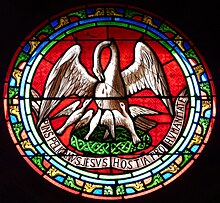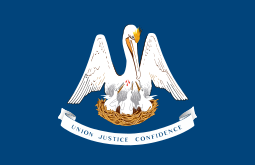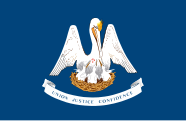|
Flag of Louisiana
The flag of Louisiana consists of a rectangular field of blue with the arms of Louisiana, a pelican vulning herself, in white in the center, with a ribbon beneath, also in white, containing in blue the state motto: "Union Justice Confidence". The flag was officially adopted July 1, 1912, and is often referred to as the Pelican flag.[1] HistoryAs early as 1812, the brown pelican appeared on the Louisiana state seal, various militia company colors, and uniform buttons, including on a flag with a blue field and the phrase "Union, Justice and Confidence".[2]: 449 First flagOn February 11, 1861, the state adopted a flag with a pale yellow star in a red canton and thirteen blue, white, and red stripes. The first flag was used until the end of the Civil War.[3] The flag represented the 13 stripes of the U.S. flag, along with the red, white, and blue of the French tricolor and the yellow and red of the Spanish flag.[2]: 450
1912 FlagIn 1878, after the end of Reconstruction in Louisiana, the pre-Civil War flag with a white pelican on a blue field came into common use; however, it was not designated as the state's official flag by an act of the legislature.[4] On June 5, 1912, Rep. William F. Roy of St. Bernard Parish introduced legislation adopting "that flag now in general use" as the state's official flag. The bill was drafted by W. O. Hart of the Louisiana Historical Society, which had endorsed the idea in April 1912. The flag was described at the time as "a solid blue field with the coat of arms of the State, the pelican feeding its young, in white in the center, with a ribbon beneath, also in white, containing in blue the motto of the State, 'Union, justice and confidence'".[5][6] The bill passed the Louisiana House of Representatives on June 13 by a vote of 71–1.[7] The state Senate followed suit on June 28, approving the measure 32–0.[8][9] However, beyond stating that the pelican be rendered "in white", the 1912 law did not specify details about the design of the pelican, its number of chicks, or other details, which led to variations in the bird's appearance over the years.[10] Even the shade of blue for the flag varied.[2]: 450 21st-century standardizationDuring the 19th century, it was traditional on the state flag and seal for the pelican in her piety to have three drops of blood on her chest.[11] In later years, however, the tradition (on both the state flag and seal) was haphazardly followed, which was noticed by an eighth-grader at Vandebilt Catholic High School in Houma, who brought this to the attention of his state legislator.[11] On May 25, 2006, a law was enacted requiring the flag to include "an appropriate display of three drops of blood" on the pelican's breast;[12][13] however, it wasn't until November 22, 2010, that a formal redesign of the flag with standardized imagery was formally introduced.[14][15] Baton Rouge artist Curtis Vann Jr., who was hired to design a standardized pelican for the updated flag, used a more realistic depiction of a brown pelican for his design, although rendered in white as required by law, but he also incorporated the brown pelican's yellow–brown crown. The design also specified an azure field and removed "and" from the banner beneath the pelican's nest.[15][10]
Symbolism In medieval lore, pelicans were believed to be attentive to the needs of their chicks to the point of drawing their own blood to feed their chicks when no other food was available. This image of the pelican in her piety came to symbolize the Passion of Jesus and the Eucharist.[16][17] William C. C. Claiborne, the first governor of the Orleans Territory, selected a pelican for the territory's first seal and it was a common state symbol prior to being formally adopted in 1912 as part of the state flag.[18] Pledge of allegianceThe Louisiana Pledge of Allegiance, adopted in 1981, is as follows:
See also
References
External linksWikimedia Commons has media related to Flag of Louisiana. |
||||||||||||||||||||||||||






